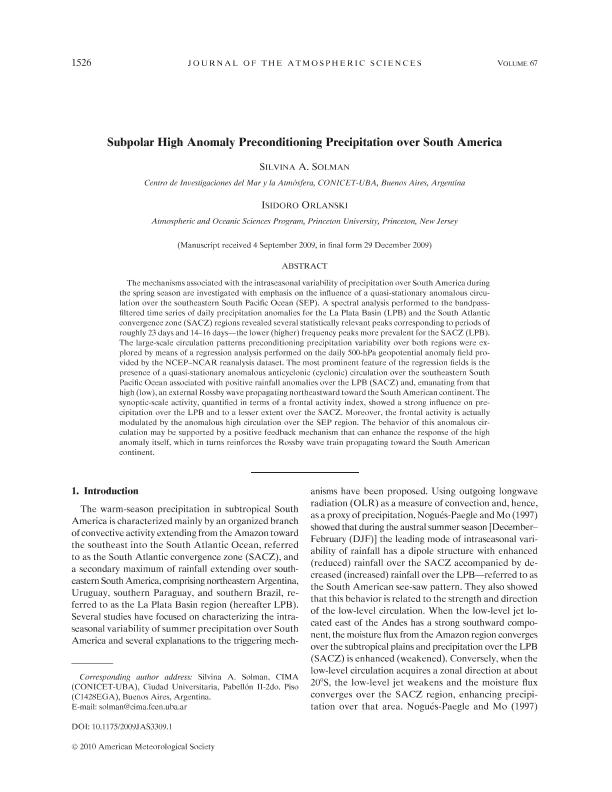Mostrar el registro sencillo del ítem
dc.contributor.author
Solman, Silvina Alicia

dc.contributor.author
Orlanski, Isidoro

dc.date.available
2017-06-01T20:47:53Z
dc.date.issued
2010-05
dc.identifier.citation
Solman, Silvina Alicia; Orlanski, Isidoro; Subpolar High Anomaly Preconditioning Precipitation over South America; American Meteorological Society; Journal Of The Atmospheric Sciences; 67; 5-2010; 1526-1542
dc.identifier.issn
0022-4928
dc.identifier.uri
http://hdl.handle.net/11336/17325
dc.description.abstract
The mechanisms associated with the intraseasonal variability of precipitation over South America during the spring season are investigated with emphasis on the influence of a quasi-stationary anomalous circulation over the southeastern South Pacific Ocean (SEP). A spectral analysis performed to the bandpass- filtered time series of daily precipitation anomalies for the La Plata Basin (LPB) and the South Atlantic convergence zone (SACZ) regions revealed several statistically relevant peaks corresponding to periods of roughly 23 days and 14–16 days—the lower (higher) frequency peaks more prevalent for the SACZ (LPB). The large-scale circulation patterns preconditioning precipitation variability over both regions were explored by means of a regression analysis performed on the daily 500-hPa geopotential anomaly field provided by the NCEP–NCAR reanalysis dataset. The most prominent feature of the regression fields is the presence of a quasi-stationary anomalous anticyclonic (cyclonic) circulation over the southeastern South Pacific Ocean associated with positive rainfall anomalies over the LPB (SACZ) and, emanating from that high (low), an external Rossby wave propagating northeastward toward the South American continent. The synoptic-scale activity, quantified in terms of a frontal activity index, showed a strong influence on precipitation over the LPB and to a lesser extent over the SACZ. Moreover, the frontal activity is actually modulated by the anomalous high circulation over the SEP region. The behavior of this anomalous circulation may be supported by a positive feedback mechanism that can enhance the response of the high anomaly itself, which in turns reinforces the Rossby wave train propagating toward the South American continent.
dc.format
application/pdf
dc.language.iso
eng
dc.publisher
American Meteorological Society

dc.rights
info:eu-repo/semantics/openAccess
dc.rights.uri
https://creativecommons.org/licenses/by-nc-sa/2.5/ar/
dc.subject
Intraseasonal Variability
dc.subject
Precipitation
dc.subject
South America
dc.subject.classification
Meteorología y Ciencias Atmosféricas

dc.subject.classification
Ciencias de la Tierra y relacionadas con el Medio Ambiente

dc.subject.classification
CIENCIAS NATURALES Y EXACTAS

dc.title
Subpolar High Anomaly Preconditioning Precipitation over South America
dc.type
info:eu-repo/semantics/article
dc.type
info:ar-repo/semantics/artículo
dc.type
info:eu-repo/semantics/publishedVersion
dc.date.updated
2017-05-31T19:44:13Z
dc.journal.volume
67
dc.journal.pagination
1526-1542
dc.journal.pais
Estados Unidos

dc.journal.ciudad
Boston
dc.description.fil
Fil: Solman, Silvina Alicia. Consejo Nacional de Investigaciones Científicas y Técnicas. Oficina de Coordinación Administrativa Ciudad Universitaria. Centro de Investigaciones del Mar y la Atmosfera. Universidad de Buenos Aires. Facultad de Ciencias Exactas y Naturales. Centro de Investigaciones del Mar y la Atmosfera; Argentina
dc.description.fil
Fil: Orlanski, Isidoro. University of Princeton; Estados Unidos
dc.journal.title
Journal Of The Atmospheric Sciences

dc.relation.alternativeid
info:eu-repo/semantics/altIdentifier/doi/http://dx.doi.org/10.1175/2009JAS3309.1
dc.relation.alternativeid
info:eu-repo/semantics/altIdentifier/url/http://journals.ametsoc.org/doi/abs/10.1175/2009JAS3309.1
Archivos asociados
